Fine Coins Showcase
Antiquities Showcase
Hide empty categories
Shop Search
Shopping Cart
My FORVM
Contact Us
About Forum
Shopping at Forum
Our Guarantee
Payment Options
Shipping Options & Fees
Privacy & Security
Forum Staff
Selling Your Coins
Identifying Your Coin
FAQs
zoom.asp
Home ▸ Catalog ▸ |Themes & Provenance| ▸ |Heros| ▸ |Homer||View Options:   | | | | | | Homer is a legendary ancient Greek epic poet, traditionally said to be the author of the epic poems the Iliad and the Odyssey. Smyrna was one of several cities that claimed to be the birthplace of the poet and at the source of the Meles River was a cave where the residents claimed he composed his poems. The city had a temple with a square portico in honor of Homer, which they called the Homerium. According to Strabo, they also called their bronze coins Homerium. |


Homer is a legendary ancient Greek epic poet, traditionally said to be the author of the epic poems the Iliad and the Odyssey.GB83485. Bronze AE 19, SNG Cop 186; SNGvA 2017; SNG Munchen 557; Milne Colophon 179; BMC Ionia p. 41, 43, VF, centered on a tight flan, weight 6.047 g, maximum diameter 18.7 mm, die axis 0o, Kolophon (near Degirmendere Fev, Turkey) mint, magistrate Pytheos, c. 50 B.C.; obverse Homer seated left in himation, right hand raised to chin (the thinker pose!), scroll in his left hand resting on his knees, ΠYΘΕOΣ (magistrate) downward on left; reverse Apollo standing right, phiale in right hand, kithara (lyre) in left hand, KOΛOΦΩNIΩN downward on left; SOLD
Smyrna, Ionia, 2nd Century B.C.


Homer is a legendary ancient Greek epic poet, traditionally said to be the author of the epic poems the Iliad and the Odyssey. Smyrna was one of several cities that claimed to be the birthplace of the poet and at the source of the Meles River was a cave where the residents claimed he composed his poems. The city had a temple with a square portico in honor of Homer, which they called the Homerium. According to Strabo, they also called their bronze coins, this very type, Homerium.SH66268. Bronze Homerium, Milne Smyrna 324; BMC Ionia, p. 245, 91; SGCV II 4572, VF, weight 7.921 g, maximum diameter 20.6 mm, die axis 0o, Smyrna (Izmir, Turkey) mint, 2nd century B.C.; obverse laureate head of Apollo right; reverse Homer seated left in himation, right hand to chin (thinker pose), volume on knees in left hand, transverse staff between legs and on far side, IMYPNAIΩN downward on right, ΗPAKΛΕIΔΗΣ (magistrate's name) downward on left and monogram outer left; SOLD
Smyrna, Ionia, 2nd Century B.C.


Homer is a legendary ancient Greek epic poet, traditionally said to be the author of the epic poems the Iliad and the Odyssey. Smyrna was one of several cities that claimed to be the birthplace of the poet and at the source of the Meles River was a cave where the residents claimed he composed his poems. The city had a temple with a square portico in honor of Homer, which they called the Homerium. According to Strabo, they also called their bronze coins, this very type, Homerium.SH66578. Bronze Homerium, Milne Smyrna 300; SNG Cop 1127 ff. var. (magistrates); SNG Tüb 3175 ff. var. (same); BMC Ionia, p. 244, 79 ff. var. (same), VF, green patina, flan adjustment marks, weight 8.091 g, maximum diameter 21.7 mm, die axis 0o, Smyrna (Izmir, Turkey) mint, 2nd century B.C.; obverse laureate head of Apollo right; reverse Homer seated left in himation, right hand to chin (thinker pose), volume on knees in left hand, transverse staff between legs and on far side, ΣMYPNAIΩN downward on right, magistrate's name ΔIOΔPOΣ / ΦANAΓOPOΣ (magistrates names) on left; SOLD
Smyrna, Ionia, 2nd Century B.C.
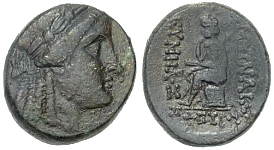

Homer is a legendary ancient Greek epic poet, traditionally said to be the author of the epic poems the Iliad and the Odyssey. Smyrna was one of several cities that claimed to be the birthplace of the poet and at the source of the Meles River was a cave where the residents claimed he composed his poems. The city had a temple with a square portico in honor of Homer, which they called the Homerium. According to Strabo, they also called their bronze coins, this very type, Homerium.GB50063. Bronze Homerium, BMC Ionia, p. 246, 104, VF, weight 7.978 g, maximum diameter 21.4 mm, die axis 0o, Smyrna (Izmir, Turkey) mint, 2nd century B.C.; obverse laureate head of Apollo right; reverse Homer seated left in himation, right hand to chin (thinker pose), volume on knees in left hand, transverse staff between legs and on far side, IMYPNAIΩN downward on right, magistrate's name EYMHΛOΣ downward on left, IΩΠYPOY below; SOLD
Smyrna, Ionia, 105 - 95 B.C.
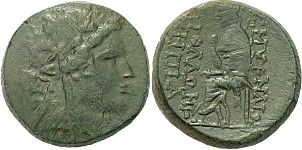

Homer is a legendary ancient Greek epic poet, traditionally said to be the author of the epic poems the Iliad and the Odyssey. Smyrna was one of several cities that claimed to be the birthplace of the poet and at the source of the Meles River was a cave where the residents claimed he composed his poems. The city had a temple with a square portico in honor of Homer, which they called the Homerium. According to Strabo, they also called their bronze coins, this very type, Homerium.GB71327. Bronze Homerium, Milne Smyrna 285; SNG Cop 1155; cf. BMC Ionia, p. 244, 79 ff. (magistrates), VF, nice green patina, soft strike, flan adjustment marks, weight 7.927 g, maximum diameter 20.6 mm, die axis 0o, Smyrna (Izmir, Turkey) mint, magistrates Apollonios and Sepia, 105 - 95 B.C.; obverse laureate head of Apollo right; reverse Homer seated left in himation, right hand to chin (thinker pose), volume on knees in left hand, transverse staff on far side, IMYPNAIΩN downward on right, magistrate's names AΠOΛΛΩNIOΣ / ΣΗΠIA (IOΣ ligate) on left; ex Pecunem & Gitbud & Naumann auction 16, lot 366; SOLD
Smyrna, Ionia, 2nd Century B.C.
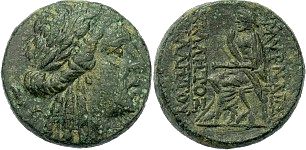

Homer is a legendary ancient Greek epic poet, traditionally said to be the author of the epic poems the Iliad and the Odyssey. Smyrna was one of several cities that claimed to be the birthplace of the poet and at the source of the Meles River was a cave where the residents claimed he composed his poems. The city had a temple with a square portico in honor of Homer, which they called the Homerium. According to Strabo, they also called their bronze coins, this very type, Homerium.
The interesting "Homer" series of Smyrna was struck by numerous magistrates, with nearly fifty coins in Copenhagen and many others in the British Museum. Our coin belongs to the "two magistrates" group, and oddly they have the same name! This name is not published by the references we consulted.
SH71727. Bronze Homerium, Milne Smyrna 339; SNG Cop 1127 ff. var. (magistrates); BMC Ionia, p. 244, 79 ff. var. (same); SNGvA 2167 var. (same), VF, well centered on a crowded flan, shallow pitting, cleaning scratches, weight 9.057 g, maximum diameter 21.0 mm, die axis 0o, Smyrna (Izmir, Turkey) mint, 2nd century B.C.; obverse laureate head of Apollo right; reverse Homer seated left in himation, right hand to chin (thinker pose), volume on knees in left hand, transverse staff between legs and on far side, IMYPNAIΩN downward on right, AXIΛΛΗTOΣ / AXIΛΛΗTOY (magistrate's name written twice) on left; rare variety; SOLD
Smyrna, Ionia, 2nd Century B.C.


Homer is a legendary ancient Greek epic poet, traditionally said to be the author of the epic poems the Iliad and the Odyssey. Smyrna was one of several cities that claimed to be the birthplace of the poet and at the source of the Meles River was a cave where the residents claimed he composed his poems. The city had a temple with a square portico in honor of Homer, which they called the Homerium. According to Strabo, they also called their bronze coins, this very type, Homerium.GB66577. Bronze Homerium, cf. SNG Cop 1127 ff.; SNG Tüb 3175 ff.; BMC Ionia, p. 244, 79 ff.; SNGvA 2167; SGCV II 4572 (all different magistrates), VF, green patina, weight 6.887 g, maximum diameter 22.2 mm, die axis 0o, Smyrna (Izmir, Turkey) mint, 2nd century B.C.; obverse laureate head of Apollo right; reverse Homer seated left in himation, right hand to chin (thinker pose), volume on knees in left hand, transverse staff between legs, IMYPNAIΩN downward on right, ...TOMΕNΗΣ (or similar, magistrate's name) downward on left; SOLD
Smyrna, Ionia, c. 145 - 125 B.C.
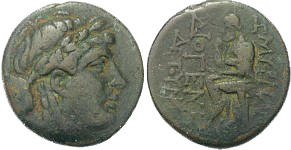

Homer is a legendary ancient Greek epic poet, traditionally said to be the author of the epic poems the Iliad and the Odyssey. Smyrna was one of several cities that claimed to be the birthplace of the poet and at the source of the Meles River was a cave where the residents claimed he composed his poems. The city had a temple with a square portico in honor of Homer, which they called the Homerium. According to Strabo, they also called their bronze coins, this very type, Homerium.GB90103. Bronze Homerium, Milne Smyrna 183a; SNG Cop 1140; BMC Ionia, p. 245, 93 var. (magistrate, monograms); SNGvA 2167 var. (same); SNG Tüb 3175 var. (same), gF, weight 7.057 g, maximum diameter 21.1 mm, die axis 45o, magistrate Diogenes Euyrd-, Smyrna (Izmir, Turkey) mint, c. 145 - 125 B.C.; obverse laureate head of Apollo right; reverse Homer seated left in himation, right hand to chin (thinker pose), volume on knees in left hand, transverse staff on far side, IMYPNAIΩN downward on right, ΔIOΓΕΗNΣ/TOY (magistrate name) in two downward lines on left, second line flanked by monograms; SOLD
Smyrna, Ionia, 2nd Century B.C.
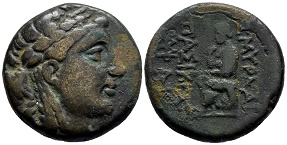

Homer is a legendary ancient Greek epic poet, traditionally said to be the author of the epic poems the Iliad and the Odyssey. Smyrna was one of several cities that claimed to be the birthplace of the poet and at the source of the Meles River was a cave where the residents claimed he composed his poems. The city had a temple with a square portico in honor of Homer, which they called the Homerium. According to Strabo, they also called their bronze coins, this very type, Homerium.GB93595. Bronze Homerium, Milne Smyrna 185; BMC Ionia p. 245, 86; SNG Cop 1142; SNGvA -, VF/F, well centered on a tight flan, patina flaking, weight 8.453 g, maximum diameter 19.5 mm, die axis 0o, Smyrna (Izmir, Turkey) mint, magistrate Pasikrates, 2nd century B.C.; obverse laureate head of Apollo right; reverse Homer seated left in himation, right hand to chin (thinker pose), volume on knees in left hand, transverse staff between legs and on far side, IMYPNAIΩN downward on right, ΠAΣIKPATHΣ (magistrate's name) and
 (monograms) downward on left; from the Errett Bishop Collection; SOLD
(monograms) downward on left; from the Errett Bishop Collection; SOLDSmyrna, Ionia, 2nd Century B.C.
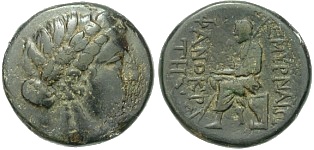

Homer is a legendary ancient Greek epic poet, traditionally said to be the author of the epic poems the Iliad and the Odyssey. Smyrna was one of several cities that claimed to be the birthplace of the poet and at the source of the Meles River was a cave where the residents claimed he composed his poems. The city had a temple with a square portico in honor of Homer, which they called the Homerium. According to Strabo, they also called their bronze coins, this very type, Homerium.GB54912. Bronze Homerium, Milne Smyrna 194; BMC Ionia, p. 244, 84; SGCV II 4572, gF, weight 8.259 g, maximum diameter 21.6 mm, die axis 0o, Smyrna (Izmir, Turkey) mint, 2nd century B.C.; obverse laureate head of Apollo right; reverse Homer seated left in himation, right hand to chin (thinker pose), volume on knees in left hand, transverse staff between legs and on far side, IMYPNAIΩN downward on right, magistrate's name ΦANOKPA/THΣ in two downward lines on left; SOLD

You are viewing a SOLD items page.
Click here to return to the page with AVAILABLE items.
The sale price for a sold item is the private information of the buyer and will not be provided.



Page created in 1.281 seconds.






